Features and schemes for planting onions in the fall before winter
Onion sets can be planted both in autumn and spring. However, pre-winter seeding has many advantages in any climate and is therefore often used. We’ll tell you what features this method has, what its advantages are, and what additional considerations should be taken into account by a gardener planting winter onions.
Features of planting onions before winter
Regardless of what type of onion is chosen, winter cultivation has features that need to be remembered.
Ripening period
Winter onions can be either mid-season or late-season. However, in any case, when planting before winter, the harvest can be harvested 3-4 weeks earlier than when sowing spring onions.
Typically, in central Russia, winter onions ripen in July. As a result, its harvesting occurs during a time more or less free from harvesting other crops. In addition, the vacated beds can be used for early-ripening crops or sown with green manure for the new season.
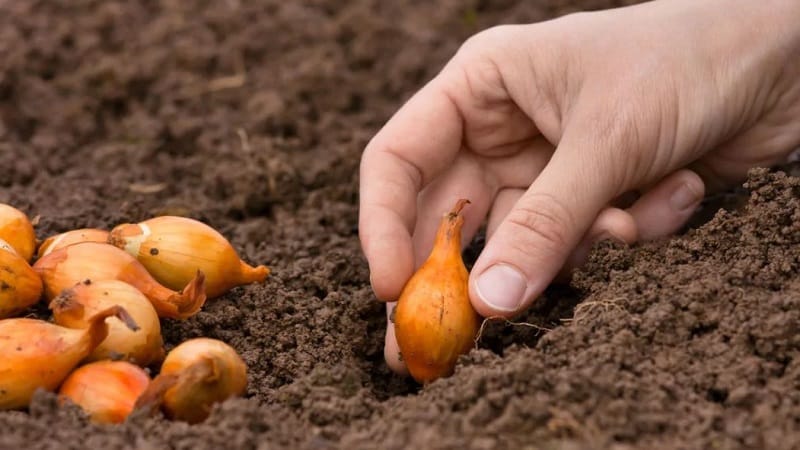
Productivity
The yield of winter onions depends on the variety. However, due to a longer growing season, winter varieties usually exceed spring varieties in yield.
When growing onions on an industrial scale, the yield of winter varieties usually averages 40-45 t/ha. With manual cultivation, this figure will be higher due to the fact that seed material and ripe bulbs are less damaged by machinery.
Important! When growing winter onions, one must take into account that losses of up to 10% of the seed material are inevitable over the winter.This also affects the yield, so you need to plan taking into account possible waste.
Characteristics of the bulb, description of appearance, taste
Many varieties of onions have already been bred for winter cultivation. Most of them has a dark yellow husk color, but there are also white varieties. The bulbs are usually round and large.
The taste of winter onions also depends on the variety., but the most common is semi-sharp. However, among the popular varieties there are also those with a pronounced pungent taste, for example, Senshui.
Regions for cultivation and climate requirements
The best regions for growing winter onions are those in which The following climate features are simultaneously observed:
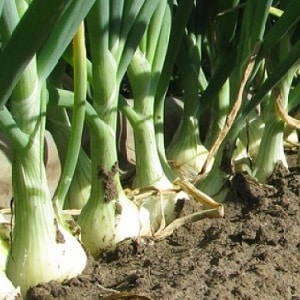 Relatively mild winters with frosts not lower than -30°C.
Relatively mild winters with frosts not lower than -30°C.- Abundant snow cover. Without snow, onions can hardly withstand frosts greater than -10°C, but with snow they can easily survive at temperatures down to -20°C and below.
- Early spring with a friendly flood.
- Warm and little rainy summer - onions love moisture, but cannot tolerate excessive dampness and rot on the vine.
Actually When using high-quality zoned seeds, winter onions can be grown throughout Russia, with the exception of the Far North and regions of Siberia with extremely cold winters.
Advantages of planting before winter
The following points are considered to be the advantages of winter onion cultivation::
- The gardener does not have a headache about where exactly to store the seeds. The fact is that seedlings are very capricious during storage; germination is often lost over the winter. Autumn planting allows you to solve this problem: the seeds overwinter in the soil in the most natural way possible for them.
- The winter onion crop matures earlier, and as a result, in the second half of the season, it can be used to grow early maturing crops, such as edible herbs or radishes.
- Onions planted before winter “diverge” in time from some pests. For example, the onion fly, which is quite annoying for spring plantings, is not particularly dangerous for winter varieties.
- Small seedlings planted before winter practically do not bolt.
The main disadvantage of winter planting – inevitable death of part of the planting material. However, losses with proper cultivation do not exceed 5-10% - in the spring you can lose more from cabbage flies or nematodes alone.
Varieties and hybrids of winter onions
Many are suitable for sowing before winter onion varieties and hybrids. In particular, gardeners often use:
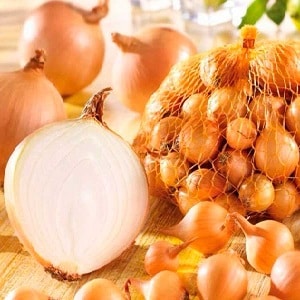 Stuttgarter Riesen (photo on the right). A variety of German selection. It has a yellowish-brown skin. The bulbs are distinguished by their large sizes - specimens weighing up to 250 g or more are often found. Has a long shelf life.
Stuttgarter Riesen (photo on the right). A variety of German selection. It has a yellowish-brown skin. The bulbs are distinguished by their large sizes - specimens weighing up to 250 g or more are often found. Has a long shelf life.- Centurion. High-yielding non-shooting hybrid. Bulbs can be stored for up to 8 months.
- Shakespeare. A winter-hardy onion variety that can withstand snowless winters with frosts down to -18°C. One of the most popular winter varieties for cottages and vegetable gardens.
- Danilovsky 301. Mid-season variety with purple scales and pulp. Resistant to frost and pests. It has a sweetish and not too spicy taste. Keeping quality is lower than that of Stuttgarter and Centurion, but also not bad.
- Senshui. An early ripening variety with yellow-brown scales. Resistant to bolting and downy mildew. It has a bright pungent taste.
In any case, you need to choose for winter planting those varieties that have been zoned in a specific agricultural region.You can check this on the official website of the State Sort Commission.
Important! You should not use varieties intended for spring planting for sowing before winter. They do not tolerate wintering well and suffer from bolting, and due to winter damage, such varieties ripen even later than when planted in spring. As a result, all the benefits of winter cultivation are lost. As a last resort, you can plant a rejected spring seed before winter, but you must remember that most of the seed will die.
Preparing the soil for autumn planting
First of all, you need to choose the right site.
To the plot the following requirements apply:
- Absence of predecessors prohibited by crop rotation rules. For example, you cannot plant onions over onions or garlic. The best predecessors are peas, soybeans, beets, cabbage and grains.
- Sufficient lighting during the day.
- Elevation. Onions do not like excess moisture, so they cannot be planted in lowlands where melt water accumulates in the spring.
The ideal location would be the area that is free of snow first in the spring. and warms up in the sun. If this is not the case, you need to make a bulk bed or surround the plot with drainage grooves.
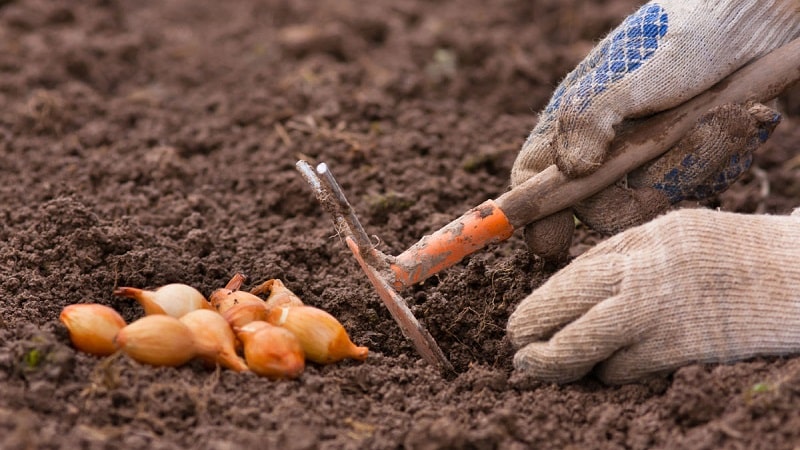
Onions love moderately loose soil, therefore, if the site has clay soil, it is necessary to structure it. To do this, add coarse clean sand when digging. If, on the contrary, the soil is too sandy, you need to add good turf soil.
Onions do not like overly acidic soil. Therefore, if excessive acidity is detected when testing the soil extract with litmus paper, the area should be limed.For the same reason, you should not use low peat as a fertilizer for onion plots: it structures the soil well and enriches it, but at the same time it acidifies it.
Before planting winter onions, fertilizer should be applied.. A good option for any soil includes per 1 sq. m beds the following means:
- from 3 to 5 kg of high-quality humus;
- 1 cup wood ash;
- 1 tsp each nitrogen, potassium and phosphorus fertilizers;
- 1 tbsp. l. combined product “Agricola for garlic and onions”.
And here introducing pure manure is undesirable: it will rot only in the spring, when it will be of little use for seed.
Selection of planting material and preparation
Seed preparation for winter planting, as for spring planting, includes includes calibration, soaking and disinfection.
Soak
Whether soaking seedlings is necessary for autumn planting is a controversial issue. The point is that here the following factors are significant:
- Soaked onions grow much faster. In addition, at this stage it becomes clear which seeds are suitable for planting and which are not germinating.
- Onions that have developed too much before frost will die. The leaves won't survive the snow anyway. Here you need to proceed from the climate and planting time. Dry onions in the soil are not particularly afraid of frost, but swollen onions are not resistant to them.
In the event that you still decide to soak, use the following methods:
- Saline solution – 1 tbsp. l. salt per 1 liter of water. The bulbs are immersed in it for 5 minutes.
- Copper sulfate - 1 tbsp. l. for 1 liter of water. Soaking time – 3-5 minutes.
- Potassium permanganate. The bulbs are placed in a rich pink solution for the same time.
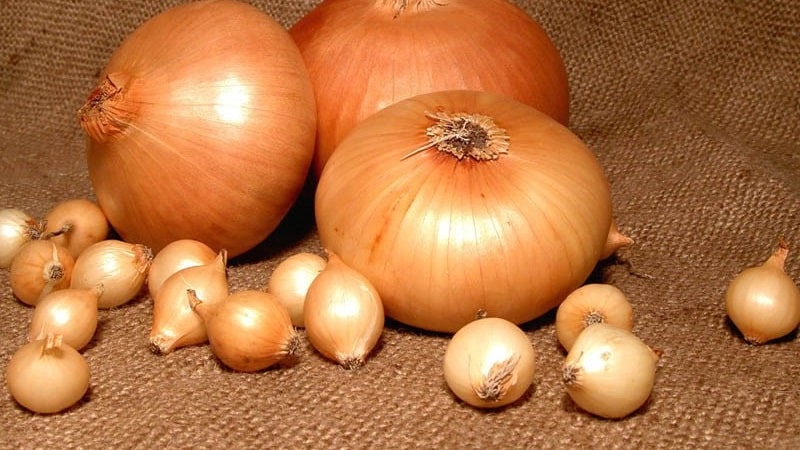
After soaking is complete, dry the onions on cloth or paper for 24 hours. After this, you can start planting.
Important! It is possible to combine soakings. In this case, the onion is placed in a saline solution for 3 minutes, and then, without drying, transferred to a container with vitriol or potassium permanganate.
Treatment
It is very useful to treat the seed material with special preparations before planting., except for potassium permanganate and vitriol. Here preference should be given to “Fitosporin”. It perfectly disinfects onions and then stimulates development in the soil. To do this, the drug is diluted in the dosage specified by the manufacturer (it is different for different types of product), and then the planting material is placed in the prepared solution for 10-15 minutes, after which, after drying, it is planted in the soil.
Other
In addition to soaking and treatment with preparations, the seed material needs to be calibrated.
Seeds are divided into the following categories:
- Oatmeal - bulbs less than 1 cm in size. They are planted only before winter and only on turnips.
- Sevok. These are bulbs up to 1.5 cm in diameter. They grow well and don't bolt. They are planted on turnips.
- Samples. Large seeds measuring 2 cm and above. They are planted on greens or already on seeds, because they will certainly produce flower stalks in the spring.
- Pacifiers. They are soft and flaccid to the touch. They are not sown because they are definitely not germinating.
Sevok and selections should be planted in different beds.
Important! Experts recommend additionally calibrating the seedlings by size and planting bulbs of approximately the same size in one bed. This measure increases the yield, and the onions sprout faster.
Scheme for planting onions in autumn before winter and cultivation features
Planting depth and seeding rate vary depending on the type of onion, but there are general points characteristic of winter cultivation.
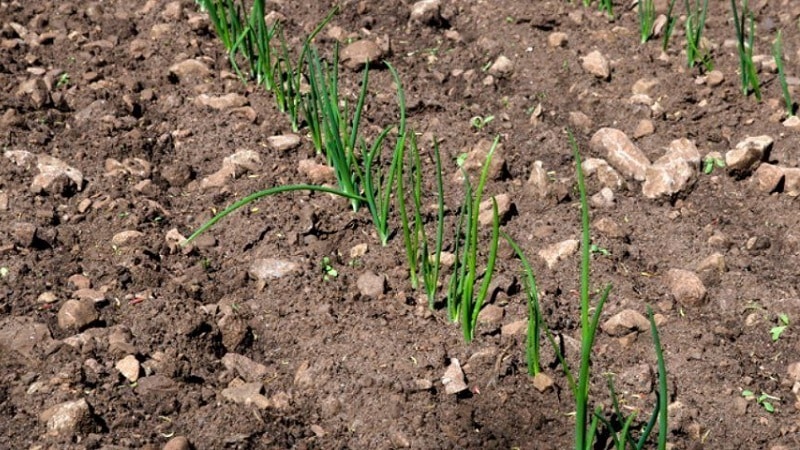
Preparation of arable land and planting material
Begin preparing onions for planting in advance. Seeds should be calibrated and selected, and if necessary, soaked.
Before sowing, the area is dug up and harrowed, carefully breaking up the lumps. Wherein fertilizing is immediately applied to the soil for future planting.
Selection of predecessors
The ideal predecessors for onions are crops with a long and deep root system (potatoes, carrot etc.). Tomatoes, cabbage, lettuce, pumpkin, legumes and other melons are also good.
Basically, onions grow well after almost all crops. The only exceptions will be spring onions and garlic - winter varieties cannot be sown after them. There will also be no good harvest after sunflower and corn.
Landing dates
Sowing time depends on the climate in a particular area. We must proceed from the fact that the bulbs should be in the ground 10-15 days before frost begins. If weather forecasters promise that the temperature during the week will be stable from +5 to +7°C during the day with a gradual decrease, this is a sign that it is time to sow winter onions.
Typically the sowing time is:
- for central Russia – mid-October;
- for the Urals and Siberia - late September or early October;
- for the south - the end of October.
Planting by seeds
When sowing onion seeds, you need to take into account that This procedure should only be carried out on frozen ground, or even on the first snow, when no thaw is expected. This is due to the fact that the seeds should begin to grow only in the spring - unlike bulbs, their seedlings do not overwinter.
Before winter, seeds are sown thicker than in spring, and additionally covered on top pre-prepared soil and spruce branches. The use of peat is undesirable: it is hygroscopic, during the first thaw it will become saturated with moisture during the day, and at night it will freeze, forming a continuous ice crust.
Planting with bulbs
Bulbs should be planted based on the following::
- The sets are planted at a distance of 7-8 cm from each other. Future bulbs need room to develop.
- The selections are planted denser - 3-5 cm apart. It is grown mainly for its feathers.
- Large bulbs planted for their greens and seeds can be sown close to each other.
After sowing the area is mulched or covered with spruce branches and left until spring. In spring, the mulch is removed.
Planting pattern, depth and distance depending on the variety
Now let's look at techniques characteristic of specific varieties of onions.
Shallot
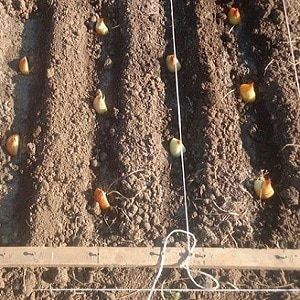 The agricultural technology for cultivating winter shallots is the same as for onions.
The agricultural technology for cultivating winter shallots is the same as for onions.
His sown at the same time according to the following scheme:
- row spacing – 30 cm;
- the distance between plantings is 15-20 cm (this is due to the fact that shallots form bushes of about 20-25 small bulbs);
- embedment depth - at least 3-4 cm.
Onion
Batun, or Tatarka, sow before winter after the onset of the first light frosts. Usually in central Russia it is the end of November. Loamy soil is chosen for planting.
Sowing is carried out according to the scheme:
- row spacing – 20-22 cm;
- embedment depth – 2 cm;
- the distance between the seeds is about 4 cm.
Decorative
Decorative onion, or allium, usually not used for food. It is grown for aesthetic purposes, although there are also edible varieties.
The landing is carried out like this:
- a hole is made three onions deep and two wide;
- the distance between the holes is from 10 (for low-growing varieties) to 25 cm (for tall ones);
- The bulbs are sprinkled with soil in the holes and lightly mulched.
Planting period is from September to October.
Bulb
Onion before winter they are planted according to the following scheme:
- planting depth is 3-4 cm, while the neck of the bulb should be 1-2 cm below the soil;
- row spacing – 15-20 cm;
- the distance between the bulbs is 8-10 cm.
It can be useful:
Onion diseases and how to deal with them
Features of caring for winter onions
Although winter onions are unpretentious, they require some care. What exactly does a vegetable grower need to do?
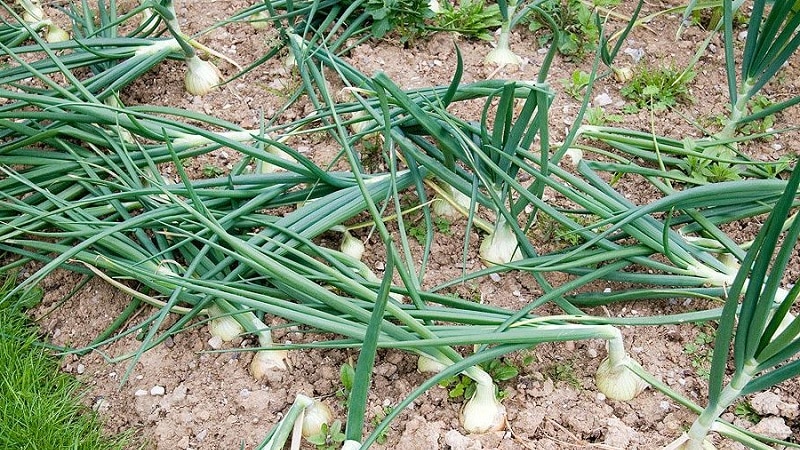
Top dressing
The first fertilizing of winter onions is carried out after emergence. For feeding use:
- ash – 1 cup per 1 sq. m;
- bird droppings solution – 1 kg per 10 liters of water;
- bred mullein.
You can also use synthetic fertilizers (saltpeter, azophosphate, superphosphate, etc.) in the dosage specified by the manufacturer. However, here it is better to underfeed the plants than to overfeed them.
If the soil is poor, repeat fertilizing after 2-3 weeks.
Watering mode
Watering onions as the soil dries out and is usually combined with loosening the soil. Here it is important at the same time not to let the plantings dry out and not to overwater them. The amount and mode of watering depend on the weather and the level of humidity in the area.
Loosening and thinning
Loosening is carried out regularly. It is also combined with weeding. When loosening, it is important not to damage the bulbs.
Thinning is required if sets are grown from seeds.. In this case, if too many plants have survived, they are slightly pulled apart in the garden bed so that at least 2-3 cm remain between seedlings.
Harvesting and storage features
Harvesting winter onions, when the husk acquires density and color, characteristic of a particular variety. Lodging of leaves is also a clear sign.
The onions are carefully dug up with a pitchfork, and simply pulled out of the loose soil by the leaves.After this, it is allowed to rest for 1-2 days so that the soil dries and crumbles, and then the leaves and roots are carefully trimmed with scissors or pruning shears. If you plan to store the onions tied into braids, it is not necessary to trim the leaves. The roots are always removed. It is important not to damage the bulb.
After trimming the onion, dry it for 3-5 days. in the sun or, if the weather is rainy, under a canopy. Then it is stored in a cool, dry room.
Useful tips
When growing winter onions, remember the following::
- Onions planted before winter are stored worse than spring onions. Therefore, the harvest must be used for food faster.
- The composition of fertilizers is selected depending on the purpose of the onion. If it is grown for feathers, when feeding, special attention is paid to nitrogen fertilizers; if on a turnip or head - potassium and phosphorus.
Conclusion
Growing winter onions has its own characteristics, but with proper agricultural technology, its yield is no lower than that of spring onions. It is important to observe the planting dates and apply the sowing scheme depending on whether the onion is grown as a turnip, a feather or a head.